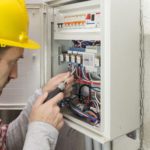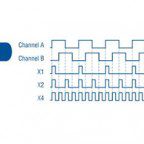
Electromechanical switches are often placed at the ends of linear axes to indicate the limits of travel. But for applications with rotary — rather than linear — motion, geared cam limit switches can perform a similar function by tracking rotations of the motor shaft and triggering switches to stop movement when the specified number of rotations has been reached.
To measure shaft rotations, geared cam limit switches — also referred to as rotary limit switches — use a geared input and a series of cams. The input shaft of the rotary switch assembly is coupled to the motor, and as the motor shaft rotates, it turns the input gear. Cams are mounted concentrically with the gears, so as the gears turn, the cams rotate, and rocker arms attached to the cam lobes trip switches at set positions.

Image credit: TER
The input gear is typically a worm gear, but planetary and spur gear versions are also available, with the gear type depending primarily on the required gear ratio. The positions (rotations) at which the switches are activated depend on the ratio of the input gear and the design of the cam lobes. Geared cam limit switches are suitable for a wide range of applications, speeds, and switching requirements, with manufacturers offering gear ratios ranging from 1:1 up to 9000:1 or higher on some designs.
Each limit switch assembly uses at least two cams and two switches (one for each end, or upper and lower limit, of travel), although many designs incorporate four or more switches for intermediate position control as well. The cams can be manually adjusted via fine-pitch screws to precisely “dial-in” the switching positions. More sophisticated geared cam limit switches allow a potentiometer, resolver, or encoder to be integrated with the switch assembly, so the device provides not only the safety of the limit and position switches, but also position feedback and control.

Image credit: Micronor
The integrated switches are typically normally closed (NC) types with positive-opening contacts, making them suitable for safety applications. The use of positive-opening, snap-action contacts also means there is no minimum motor speed required in order for the switches to operate properly, and maximum allowable speeds typically range from 500 to 2000 rpm.
Geared cam limit switches can be used for any application where switches should be activated based on rotations (partial or multiple) of a motor shaft, including industrial equipment such as packaging machines and winders. And they’re often used for lifting and lowering equipment such as hoists and cranes, where linear movement of the device is difficult to measure directly.







Leave a Reply
You must be logged in to post a comment.